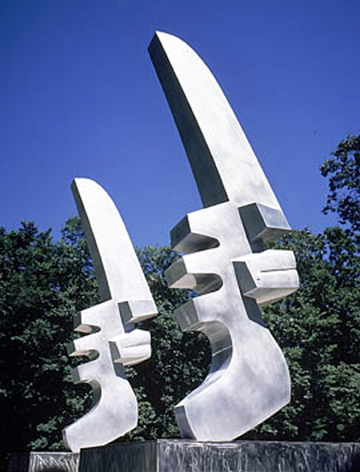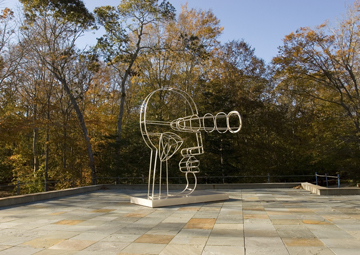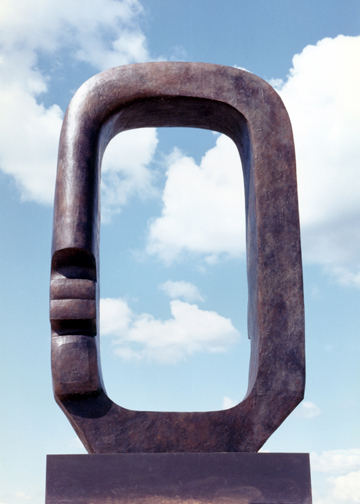Art Essay: Thoughts on Creation
By Elizabeth Strong-Cuevas
ART TIMES Spring 2013
 Elizabeth Strong-Cuevas “Running Heads” Elizabeth Strong-Cuevas “Running Heads” |
Creation begins with a wish, a desire to do something, to make something, to see beyond the immediate reality. If we are lucky, it will open a door to a stream of thought that is inspiration. We inspire, we breathe in ideas.
In sculpture, the body comes into play. We are mostly on our feet and we dance also with our hands. We play, we discover with our hands. In Gupta India, I have read, you had to be a dancer in order to be a sculptor.
I believe that I arrived here programmed. In the back brain, the subconscious, perhaps all potential consciousness resides. From that vast ocean, certain thoughts arise, dictating our future.
In my case, I think I was always meant to do what I do, but it was not to be immediately. I had to wait thirty years to begin.
For any talk or event, I use the title “Premonitions in Retrospect”. That phrase pretty well describes my beginnings.
When I first walked in to the Art Students’ League in the early 60’s, I had a set of flashbacks, the earliest one when I was six years old. I said to myself: “If I wanted to, I could make a watch.” I felt I had skill in my fingers. The second memory that assailed me was being taken to a fortuneteller’s stall outdoors in Lakewood, NJ where we were staying. Right now, I can see the bamboo stalks lining the stall. The woman telling fortunes looked at my palm and said: “You will be an artist.” I didn’t believe it but thought — if only it could be true — how wonderful. My father likes art and artists.
 Elizabeth Strong-Cuevas “Two Face Telescope” Elizabeth Strong-Cuevas “Two Face Telescope”in Amagansett Park, NY |
There are several other moments that seem to indicate what was to come. I shall mention only one. In my twenties, married to a French businessman, one day he brought in a set of snapshots. The only one I can remember was a Maillol cast of a woman, lying in a foundry. As if it were worlds away from me, unattainable, I said to myself with such emphasis, as though shouting aloud: “Oh, what a delicious life!”
I think that such striking moments that mark our lives tell us something. They give us an indication of where we may be going.
In my case when I began this new life in sculpture, at last, I felt it was right. I have never looked back. It seems to me it was what I was always meant to do.
The remarkable Armenian teacher John Hovannes, after a few months, took me aside. He said: “Now, a little more imagination, a little more composition, you carve”. I didn’t believe I could do it at first. Under his guidance, I bought a block of marble about a foot and a half square out of which I carved an Indian deity leaning against a tree. When I got to the face, I lost nerve. Hovannes pounded the table in the coffee shop and gave me marching orders: “You carve that face”. Although I broke the nose slightly, it was a feat that I managed. I lost my fears.
 Elizabeth Strong-Cuevas “Coincidence 2” silver Elizabeth Strong-Cuevas “Coincidence 2” silver |
Soon after John Hovannes’ death in the 70’s, I met Marcel Meylan, a French-Swiss sculptor who had made enlargements for Zadkine. He had been foreman of a jewelry shop and had made an anti-magnetic watch during the last war. He put me on the large scale with jeweler’s armatures for plaster pieces such as "Arch III", the five "Heads" with moveable profiles in stainless steel, "Obelisk", and others. He had a teacher’s pride. He was never so happy as when he saw me on a scaffold, 7 feet up. He would say: “At last, Elizabeth, I have made a sculptor of you.”
After Meylan returned to Switzerland, having spent about eight years in New York City, I met an amazing welder Michael Cain with whom I began fabricating large aluminum sculpture: "Running Heads", "Arches", "Two Face Telescope". I do not weld but I make the models and I supervise the building of large-scale pieces. I have never made an automatic enlargement. I always extend measurements for any sculpture over five feet and I make forms lean inward, following intuitively classical Greek principles.
Today I work with another sculptor Mark Briscoe who likes fabricating stainless steel: "Pillars", "Galactic Lens", "Look Twice", etc.
For the making of sculpture, it is as if I had been given a red carpet. My teachers have been outstanding, my helpers, exceptional. I have never had to turn anyone away. We have advanced together. It gives one great pleasure.
 Elizabeth Strong-Cuevas “Arch III” Elizabeth Strong-Cuevas “Arch III”bronze in public sculpture garden |
What inspires me, what are my themes? I like thinking about physics, the Universe. And I am drawn to spiritual ideas, Yoga. In my double profiles, I am trying to show the underlying unity of minds. In my negative spaces, I am showing spirit beyond matter, idea before material form. Somewhere, in a sculpture showing the Buddha and his disciples, the disciples are shown in three-dimensional form while the Buddha is represented only by the impression of his feet in the sand. My grandfather was a professor of philosophy and psychology who believed in consciousness in the Universe. He wrote a letter about the consciousness of the sun and the moon. Maybe we get ideas from our ancestors. I think that thought travels, symbolized by me in a series of eight sculptures that go by that name “Thought Travels”. Nicola Tesla, like the Hindus, believed that thought is a form of energy not yet measured. We may get thoughts and feelings from a distant past. Intuition and feeling are all part of the inspiration to make something. As Picasso said when asked where he got his ideas; “It begins with an emotion.” In sum, my work refers to outward exploration and inner meditation.
I feel so lucky to have been given what I think is a mission to impart certain ideas.
To this day, I can say: “Oh, what a delicious life!”
(Elizabeth Strong-Cuevas is an internationally acclaimed sculptor whose pieces have been exhibited in Europe, the United States, and South America. Her website is sc-sculpture.com).
